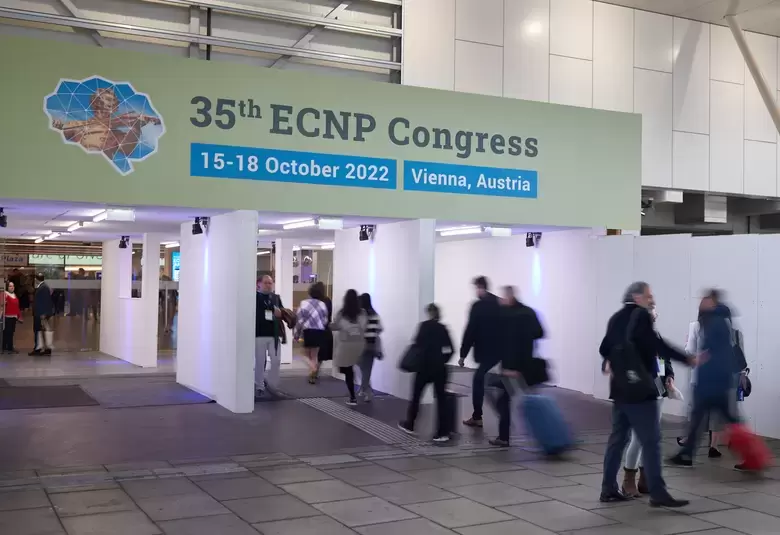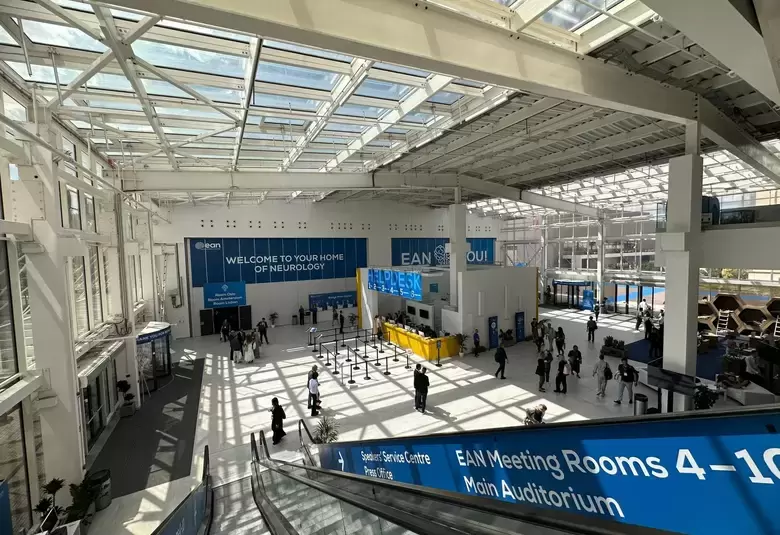Just over 20 years ago it became accepted that receptor-receptor interactions were brought about by heterodimer formation which became the centres for signal integration. That the 5-HT1A receptor can have at least 10 different protomer interactions in the CNS has brought a whole new level of complexity to our understanding of how such hub receptors function. ‘It’s becoming more complex and, therefore, more exciting!” the session’s chairman Kjell Fuxe, Sweden, told the audience. Here we report some recent findings on the role of serotonin in depression and how new targets for its management are being uncovered.
이형이합체(heterodimer) 형성을 통한 수용체 간의 상호작용이 신호 전달의 중추적인 역할을 한다는 사실이 받아들여진 것은 불과 20년 전의 일입니다. 중추신경계에서 5-HT1A 수용체가 10가지 이상의 여러 기본 단위체(protomer)와 상호작용할 수 있다는 것을 알게 되면서, 그러한 중심 수용체(hub receptor)가 어떠한 기능을 하는지 이해하는 것은 완전히 새로운 차원으로 복잡해졌습니다. 세션의 좌장을 맡은 스웨덴의 Kjell Fuxe는 청중들에게 "점점 복잡해진다는 것은 점점 흥미로워진다는 이야기가 된다" 라고 말했습니다. 여기에서 우리는 우울증에서의 세로토닌의 역할과 이를 다루기 위한 새로운 표적들이 어떻게 밝혀지고 있는지에 대하여 몇 가지 최신 지견을 보고하고자 합니다.
siRNAs as anti-depressants
항우울제로서의 siRNA
Considerable effort has gone into the development of anti-depressant drugs that specifically target serotonin and Francesc Artigas, Spain, outlined the considerable challenges accompanying research efforts. Pre- and postsynaptic 5-HT1A receptors play a major role in anti-depressant action, either by limiting (presynaptic 5-HT1A autoreceptors) or facilitating their effects (postsynaptic 5-HT1A receptors).
세로토닌을 특이적 표적으로 하는 항우울제를 개발하기 위한 많은 노력이 있었으며, 스페인의 Francesc Artigas는 연구에 공을 들인 수많은 도전에 대하여 간략히 제시하였습니다. 절전 및 절후 시냅스의 5-HT1A 수용체들은 그들 자체의 효과를 제한하거나(시냅스 전 5-HT1A 자가수용체) 촉진함으로써(시냅스 후 5-HT1A 수용체) 항우울 작용에서 중요한 역할을 합니다.
A promising new strategy for creating anti-depressants is based on use of small interfering RNA (siRNA) targeted to serotonin neurons. These siRNAs selectively reduced the expression and function of presynaptic but not postsynaptic 5-HT1A receptors. When siRNAs were injected into the raphe nuclei of mice, expression and function of 5-HT1A autoreceptors locally was attenuated, without affecting postsynaptic 5-HT1A receptors. This produced an anti-depressant-like effect in the mice - effects that are associated with enhanced forebrain 5-HT release.
항우울제를 탄생시키기 위한 새롭고 유망한 한 전략은 세로토닌성 뉴런을 표적으로 하는 small interfering RNA(siRNA)의 이용을 기반으로 하고 있습니다. 이러한 siRNA는 시냅스 전 5-HT1A 수용체의 발현 및 기능을 선택적으로 저하시켰지만, 시냅스 후 5-HT1A 수용체에 대해서는 그러한 작용을 하지 않았습니다. 마우스의 솔기핵(raphe nuclei)에 siRNA를 주입했을 때, 5-HT1A 자가수용체의 발현 및 기능이 국소적으로 약화되었으며 시냅스 후 5-HT1A 수용체에는 영향을 주지 않았습니다. 이 물질은 마우스에서 항우울제와 유사한 효과 – 전뇌(forebrain)의 5-HT 분비 증가와 관련된 효과를 나타내었습니다.
When siRNAs were injected into the raphe nuclei of mice, expression and function of 5-HT1A autoreceptors locally was attenuated
마우스의 솔기핵(raphe nuclei)에 siRNA를 주입했을 때, 5-HT1A 자가수용체의 발현 및 기능이 국소적으로 약화되었습니다
Conjugated siRNA may enhance anti-depressant effect
결합형(Conjugated) siRNA는 항우울 효과를 향상시킬 수 있습니다.
A conjugated 5-HT1AR siRNA (C-1A-siRNA) molecule specific to serotonin neurons has also been created. The molecule - created by binding 5-HT1A receptor siRNA molecules to a 5-HT selective serotonin reuptake inhibitor (SSRI) - produced similar effects to the siRNA described earlier. However, SSRI administration to C-1A-siRNA-treated mice produced a greater elevation of extracellular 5-HT than in control animals showing how drug effects can be adapted and how promising such an approach might be.
세로토닌 뉴런에 특이적인 결합형(conjugated) 5-HT1AR siRNA(C-1A-siRNA) 분자도 만들어졌습니다. 5-HT에 선택적세로토닌 재흡수 억제제(SSRI)에 5-HT1A 수용체 siRNA 분자를 결합시켜서 만들어 낸 이 분자는 앞서 설명된 siRNA와 비슷한 효과를 발휘하였습니다. 하지만 C-1A-siRNA를 처치한 마우스에게 SSRI를 투여했을 때에는 대조 동물에 비해 세포 외 5-HT의 증가가 더 크게 나타났으며, 이는 약물의 효과가 어떻게 조정될 수 있는지 그리고 그러한 접근방식이 얼마나 유망할 수 있는지를 보여줍니다.
SSRI administration to C-1A-siRNA-treated mice produced a greater elevation of extracellular 5-HT than in control animals showing how drug effects can be adapted and how promising such an approach might be.
C-1A-siRNA를 처치한 마우스에게 SSRI를 투여했을 때에는 대조 동물에 비해 세포 외 5-HT의 증가가 더 크게 나타났으며, 이는 약물의 효과가 어떻게 조정될 수 있는지 그리고 그러한 접근방식이 얼마나 유망할 수 있는지를 보여줍니다
Galanin – fragmented approach may be more potent
갈라닌 – 분절형 방법(fragmented approach)이 더 강력할 수 있습니다.
Another promising strategy for the management of depression and anxiety involves the neuropeptide galanin and its receptors. Zaida Diaz-Cabiale, Spain, explained how activation of GALR1 and GALR3 promotes depression whereas activation of GALR2 has anti-depressant effects. However, the N-terminal fragment of GAL, GAL(1-15), is also active and animal data suggest that the effects of the fragments may be more potent than those of the complete molecule.
우울증 및 불안의 관리에 있어서 유망한 또 다른 전략은 뉴로펩티드인 갈라닌 및 그 수용체와 관련되어 있습니다. 스페인의 Zaida Diaz-Cabiale는 어떻게 해서 GALR1 및 GALR3의 활성화는 우울증을 촉진하는 반면 GALR2의 활성화는 항우울 효과를 나타내는지에 대해 설명하였습니다. 하지만 GAL의 N-말단 분절인 GAL(1-15) 역시 활성이 있으며, 동물연구 자료에 따르면 이 분절의 효과는 전체 분자의 효과보다 더 강력할 수도 있는 것으로 보입니다.
Of particular interest was the finding that GAL(1–15) enhanced the anti-depressant effects induced by the 5-HT1AR agonist 8-OH-DPAT in the forced swimming test. Again, the anti-depressant effects elicited by GAL(1-15) were stronger than those induced by GAL. Importantly, GALR2 was involved in these effects, since a specific GALR2 antagonist blocked GAL(1–15) mediated actions at the behavioral and at the receptor level.
특히 흥미로운 것은 강제 수영 실험(forced swimming test)에서 GAL(1-15)가 5-HT1AR 효능제인 8-OH-DPAT에 의해 유도된 항우울 효과를 증강시키는 것으로 확인되었다는 점입니다. 다시 말하면, GAL(1-15)에 의해 유도된 항우울 효과는 GAL에 의해 유도된 효과보다 더 강력하였습니다. 특이적인 GALR2 길항제가 GAL(1-15)에 의해 매개된 행동 및 수용체 수준에서의 작용을 차단했다는 점으로 볼 때 GALR2가 이러한 효과에 관여했다는 것이 중요합니다.
Galanin – serotonin heteroreceptors enhances anti-depressant effect
갈라닌 – 세로토닌 이종수용체는 항우울 효과를 향상시킵니다
Use of proximity ligation assay (PLA) suggest the enhanced anti-depressant effects of 8-OH-DPAT occur by GAL(1-15) acting on GALR1-GALR2-5-HT1AR heteroreceptors located at postjunctional sites and at the soma-dendritic level. The development of new drugs specifically targeting these heteroreceptor complexes offers another novel strategy for treating depression.
근접 결합 분석(proximity ligation assay, PLA)에서는, GAL(1-15)가 후접합 부위(postjunctional site)에 위치한 GALR1-GALR2-5-HT1AR 이종수용체에 작용함으로써 세포체-수상돌기(soma-dendritic) 수준에서 8-OH-DPAT의 항우울 효과가 향상되는 것으로 제안하였습니다. 이러한 이종수용체 복합체를 특이적으로 표적하는(targeting) 신약 개발은 우울증 치료에 있어서 또 하나의 새로운 전략이 될 수 있습니다.
Enhanced anti-depressant effects of 8-OH-DPAT occur by GAL(1-15) acting on GALR1-GALR2-5-HT1AR heteroreceptors located at postjunctional sites
GAL(1-15)가 후접합 부위(postjunctional site)에 위치한 GALR1-GALR2-5-HT1AR 이종수용체에 작용함으로써 8-OH-DPAT의 항우울 효과가 향상됩니다
FGFR1 – 5-HT1AR - heteroreceptors with anti-depressant effects
항우울 효과를 보이는 FGFR1 – 5-HT1AR - 이종수용체
Dasiel Borroto-Escuela, Sweden, outlined a further potential anti-depressant heteroreceptor target – this time incorporating brain fibroblast-growth factor receptor 1 (FGFR1).
스웨덴의 Dasiel Borroto-Escuela는 더욱 잠재력 있는 항우울 이종수용체 표적을 - 이번에는 뇌의 섬유아세포 성장인자 수용체 1(FGFR1)와 관련하여 - 제시하였습니다.
5-HT1A-FGFR1 heterocomplexes were first described in the hippocampus and then in midbrain 5-HT neurons, where these heterocomplexes are enriched in 5-HT1A autoreceptors. Combined FGF-2 and 5-HT1A agonist treatment increased formation of these heterocomplexes, led to an enhancement of FGFR1 signaling and was associated with the development of anti-depressant effects.
5-HT1A-FGFR1 이종복합체는 처음에 해마에서 확인되었으며, 다음으로 중뇌 5-HT 뉴런에서 확인되었으며, 이 곳에서 이러한 이종복합체는 5-HT1A 자가수용체에서 풍부하게 분포됩니다(enriched). FGF-2와 5-HT1A 효능제를 결합한 치료제는 이러한 이종복합체의 형성을 증가시킴으로써 FGFR1 신호전달의 증강을 유도하였으며, 항우울 효과의 발현과 관련이 있었습니다.
Synergistic allosteric receptor-receptor interactions contribute to acute anti-depressant actions by recruiting 5-HT1A autoreceptors into FGFR1-5-HT1A complexes
알로스테릭(allosteric) 수용체 간의 상승적 상호작용은 5-HT1A 자가수용체를 FGFR1-5-HT1A 복합체로 이동시킴으로써(recruiting), 급성(acute) 항우울 작용에 기여합니다
Thus, 5HT1A heteroreceptor complexes may serve as targets in the management of depression. These complexes are of special interest as they are located in the midbrain raphe and hippocampal neuronal system. In particular, synergistic allosteric receptor-receptor interactions following coactivation of post-junctional FGFR1-5-HT1A heteroreceptor complexes in the hippocampus may exert rapid and robust anti-depressant actions. One drawback may be the development of hippocampal atrophy over time.
따라서, 5HT1A 이종수용체 복합체는 우울증 관리의 표적이 될 수 있습니다. 이러한 복합체들은 중뇌 솔기(raphe) 및 해마 신경계에 위치한다는 점에서 특별히 관심을 끌고 있습니다. 특히 해마에서 후접합 FGFR1-5-HT1A 이종수용체 복합체의 공동 활성화 이후 알로스테릭 수용체 간의 상승적 상호작용은 신속하고 확실한 항우울 작용을 발휘할 수 있습니다. 한 가지 단점은 시간이 지나면서 해마 위축이 발생할 수 있다는 것입니다.
5-HT1A autoreceptor-FGFR1 heteroreceptor complexes are found in the midbrain 5-HT raphe cells and at the soma-dendritic level. Here, synergistic allosteric receptor-receptor interactions upon co-activation may contribute to acute anti-depressant actions by recruiting 5-HT1A autoreceptors into FGFR1-5-HT1A complexes.
5-HT1A 자가수용체-FGFR1 이종수용체 복합체는 중뇌 5-HT 솔기 세포 및 세포체-수상돌기(soma-dendritic) 수준에서 발견됩니다. 이 때에, 공동 활성화 시에 나타나는 알로스테릭 수용체 간의 상승적 상호작용은 5-HT1A 자가수용체를 FGFR1-5-HT1A 복합체로 이동시킴으로써 급성 항우울 작용에 기여할 수 있습니다.
Thus, the FGFR1-5-HT1A heteroreceptor complex is a new promising target for anti-depressant drugs including combined treatment with FGF2 and 5-HT1A agonists in major depression.
따라서, (FGF2 및 5-HT1A 효능제 병합요법을 포함하여) FGFR1-5-HT1A 이종수용체 복합체는 항우울제 개발의 새롭고 유망한 표적(target)입니다.
본 자료는 Global Lundbeck 의학부에서 선별한 콘텐츠이며, 한국룬드벡의 의견과 다를 수 있습니다




